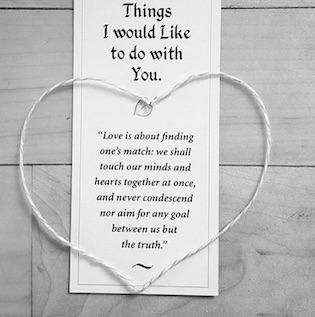How to Write a Book.
Note: this list goes to 11, baby.
If you don’t care about your own environmental impact or writing something mindful, this list is not for you. Google: how to market a book through Amazon instead. Amazon is the Honey Badger of ethics: it doesn’t give a sh*t about writing, readers, publishers or, ultimately, books (Read the New Yorker article about Amazon, here, if you’d like to know more).
1. Write every day. Write at least once a week. If you’re not writing, you won’t trip upon something you want to write 250 – 500 pages about (you know, a book).
2. Do both kinds of writing: a private journal for yourself, so your inner stories can emerge. And, a blog, so you can learn to connect with readers, and see what does connect with readers (which will surprise you, as it did me).
3. Once you find your subject, do the third kind of writing: don’t just write on your own blog, publish each chapter (serialize, a la Dickens) on a major blog like elephant, Buzzfeed, Huff Post, whatever you like as long as it’s a large platform that can reach millions of reachers. If you’re an ethical nut, like me, go with mission-driven, independent media (Huff Post sold to AOL, for example).
4. Make sure your serializations all link to a newsletter for your book, so folks can sign up to read more chapters and get the book. Make sure you link to a Facebook page for your book (my serializations of Things I would like to do with You, my first book, totaled millions of readers and 150,000 Facebook fans—all before my book was published. This will be the platform on which you can do step #7.
5. Listen. Read readers’ comments. If you’re not getting comments, that’s its own kind of comment. A good book is both genuine and personal, and connects with its readers. If you’re not connecting on a major blog, this is an early warning that your book will not connect. Do not give up: just dig deeper and make sure you’re writing about something you know, and that will be helpful to others. Respond to comments. Build community.
6. Once you’re done—if you want to publish independently—start a Kickstarter. Include editing in your budget. I asked for $35,000, which is a ton, and readers gave $53,000, which is a tonne. That said, I didn’t include my entire print bill, since that would have been…way more. Eco printing is pricey, as you’ll see below. Prepare to devote your attentions to your Kickstarter—I tried to message every single one of my Facebook friends, which was overwhelming, and to respond to everyone, which was overwhelming, and I failed frequently, which was depressing. The whole experience was fun and overwhelming and touching and scary and stressful. You know, like starting a new business.
7. Now that you’ve got a budget going, hire a friend or two or three (I think six editors helped me, with two being principal and consistent, and one being the boss) and start editing. Prepare to edit for years. I think editing (two years, nearly?) took me longer than writing (one year). You’re putting something into print, not online, so you’ll want zero typos, and some nice design, and to cut anything extraneous (there will be a lot—my writing veered from “perfect” to “monumentally shiite” from one paragraph to the next).
8 & 9: Printing and Mailing. Contact a few printers. I chose to print “eco,” including in the US of A. In fact, I printed locally—only 22 blocks from my house. My print job has just begun, and yet it’s helping the printer employ folks and get Christmas bonuses and is the biggest job they’ve ever had. It’s a cause for celebration, for them, and heartwarming for me. Real human beings create these books! Make sure they’re reasonably well-paid and treated. So: I printed 2000 and change, which cost…a lot. About 10 or 11 bucks per book, since it was a small run. That was enough to mail everybody on Kickstarter and other pre-orders. Then, I printed 20,000 books, which may not sound like much, but it costs…a lotttt. Let’s just say I wrote the biggest check of my life and had to endure a week or two of my accountant losing faith in me. In so doing, I got the price down to just under 8 bucks per book, which helps. Remember: if you print in China, with plastic-coated cover and toxic ink and crap paper, you’ll be paying $1.50 a book, or something. So every dollar you can shave off will make a big difference. Treat the printer with respect, but push them, too. You are their partner and boss, and they are your partner and boss. Stay in touch constantly. They can also help you with fulfillment (ie, mailing thousands of books), or you can do yourself. We’ve done both, and I much prefer mailing ourselves (I can employ someone, use paper instead of plastic tape, and we can write the addresses with love and put hearts on the packaging—a personal touch that means something to us and the reader who invested in my words on faith). Prepare for a 10 x 30 area of your office/home to turn into Santa’s workshop, if you’re handling the mailings. Re the printing: all books are plastic-coated. I got rid of that. All books have toxic ink—unless they’re veggie inks, which is better, but still awful. I used veggie inks. All books have toxic glue, but not much of it. I selected paper that was from a sustainably-managed tree farm (FSC, Rainforest Alliance are good ways to go) and further offset the purchase of every single book with the planting of a tree to offset the carbon impact (though I’m moving the offsets to helping rescue orphaned baby elephants). Think about offsets: even if your book is eco, like mine is overall, the impact is still horrible—printing and binding and shipping books is intense stuff. Finally, add a page to the end of your book to talk about the choices you made, so that readers can learn how evil books are, physically, and begin to learn and support ethically-printed books. In terms of mailing, make sure you have a well-organized mailing list from the beginning. Key point here. Read that twice.
10. Now you have the book in your hands. I hope you’ve built up your Facebook and Instagram and blog and big blog followings, and kept email addresses and developed a newsletter—’cause you’ll need ’em. Share it all up. Don’t regard your sharing as marketing, or sales. Regard it as communicating the fun or pith of your book and message—folks will react to that. That said, once in awhile, just offer the book straight up. That works, too.
11. Tour. If you can afford a tour (build it into your Kickstarter budget), tour. You can tour cheaply. You’ll need to contact book stores in advance (in my case, I’m reaching out to readers themselves who may want to host home readings and can invite 20 or more friends, yoga studios, galleries, universities, retreat centers, conferences, festivals, cafes that host open mic nights). If you have friends scattered around, stay in their spare bedroom. Take a train, bus, bike tour…try to avoid plane. It’s pricey and tiring and awful for our environment. If you do fly, offset.
Note: if you run a studio or cafe or bookstore or festival and would like to host a reading & discussion of Things I would like to do with You in your home and can invite 20 or more folks, let us know and Waylon will come to you. We can split book sales). Contact: [email protected]: our grassroots tour won’t happen without you. We’ll be in LA in March and are looking for a location! We’ll also be in Portland, Seattle, San Francisco, Denver, Ft. Collins, New York and 20 other college towns and cities—contact us to host an appearance.
Hope this walk-through of an eco-responsible, independent, grassroots book journey was helpful. If you have questions, comment and I’ll reply in more depth.
To get Things I would like to do with You: elephantjournal.com/books.
Yours in the Vision of Enlightened Society,













Read 14 comments and reply